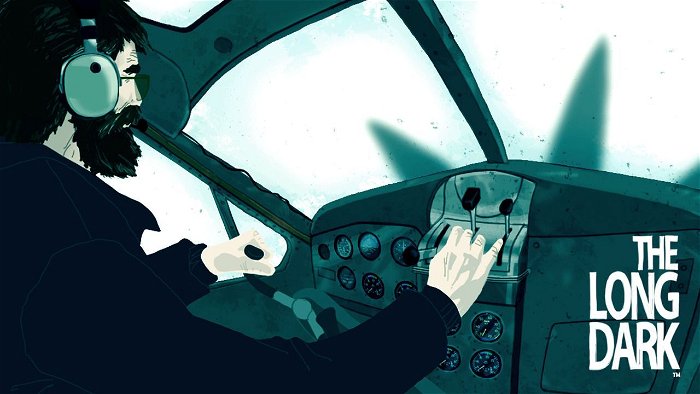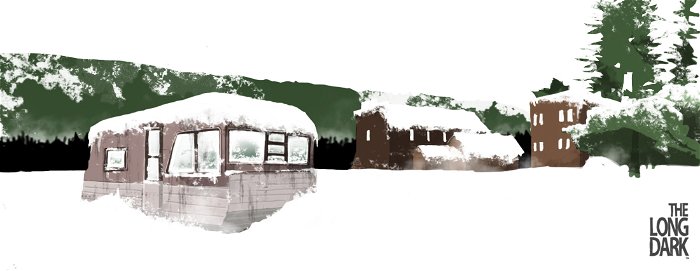Raphael van Lierop and the rest of the highly-talented Hinterland team are working on an upcoming project called The Long Dark, a first-person, post-disaster survival-simulator.
The Kickstarter project has accumulated over $83 000 in its first two weeks, is backed by the Canada Media Fund, and is set to release next fall. Hinterland is a fresh face within the industry that emerged in 2012, and the ambitious team of six, which includes the likes of technical director Alan Lawrance (Saints Row IV) and writer Marianne Krawczyk (God of War), aim to create something totally unique that takes place in the Canadian wilderness.
CGM: You guys have a lot of talent working on this project who have worked on other major titles, what was the incentive for you guys to come together and create The Long Dark?
Raphael van Lierop – It had a lot to do with the fact that our core team, which is made up of veterans who have 10-20 years experience and have worked on large triple-a franchises, I think we reached a point where we’ve started to look for other challenges and I think that’s common throughout the industry today. We’re looking for new opportunities to do more personal work, and be more creative, things that are sometimes difficult within the confines of an established franchise where less risks are possible. So that was a really the starting point, and we have a common language about how things work which really helps. Everyone on the core team is world-class talent and could work on any project for any studio in the world I think, but they want to work on something more personal to them, and that comes down to being an independent studio, and working on a game that you wouldn’t see from traditional publishers. It also helps that we have a distributed team structure, so the studio is set up in Vancouver Island, but the rest of the core team lives and works out of their own home city.

I think that largely came from personal experience in the industry, where I had to move my family around for work more than once. Sometimes it works out really well and often doesn’t, and for me after I finished my last big game at Relic which was Space Marine, I said to myself there’s gotta be a different way to do this, and that was sort of the seed that started the whole process of coming up with The Long Dark and coming up with a studio that would become Hinterland. Everybody was quickly sold on the project’s concept and the studio’s concept, but the heart of the matter is that talented people want to work with other talented people. So when you announce you’ve managed to sign these great people it’s that much easier to sign even more great people. We’ve announced Mark Meer, who did the voice work for Commander Shepard, will provide the voice acting for Will Mackenzie who’s our protagonist, today we announced Elias Toufexis, another renowned voice actor in games who voiced Adam Jensen in Deus Ex: Human Revolution, will also be joining us as well. It really comes down too having a concept that’s interesting to people, and having a concept for the studio itself to get behind, and then bringing talented people in to make something great in an environment that’s more inclusive about doing more creative, more personal work.
CGM: How often is the group able to come together around a table and throw ideas around?
Raphael van Lierop: The goal is every two or three months. Recently, about three weeks ago we had an on-site together here on the island. Everyone came in and we spent a few days together in a cabin on Mt. Washington. We just hung out, talked about the game, strategized about the company, ate pancakes and played games, it was a chance to have that bonding experience. That’s one of the things that are great about working this way, like when we’re off in our respective home bases, we’re using all the tools of collaboration that are available to us through the technology like Skype, and Google tools which really makes the collaboration quite seamless.
There’s a lot of work involved to set it up and I don’t think everybody could do it, but this team is so professional and the level of experience is so high that we could definitely make it work. But then when we get together face-to-face we can really just focus on being together, and that creates a very neat ebb and flow in the way the communication and relationships work. As a result I think the team bond in certain ways is a lot stronger than it would be if we just had those coffee machine moments in between meetings, and here and there around the studio. This team structure allowed me to bring everyone together and have a very focused three or four day period where we just had to focus on being together and not worry about work, and we could do things like go for walks and just hang out and get to know each other better, and just build on our team dynamic, strengthening the unity between everyone. So far it’s been working very very well.

CGM: When you mention post-apocalypse, many people think of zombies. How important was it to stay away from the undead with this game?
Raphael van Lierop: I’ve always been fascinated with post-disaster, post-apocalyptic settings and I’m a huge fan of zombie movies and games and all the big summer-blockbuster disaster films, but I find that the genre is generally sort of over-saturated. I think what’s interesting about these post-disaster scenarios is not the zombies or anything like that, but it’s the hard situations people find themselves in and the decisions they have to make. Cormac McCarthy’s The Road had a huge impact on me. In many ways it’s a fairly traditional post-apocalyptic story, but the treatment is so elevated and very literary, and had way more impact because it didn’t fall back on a lot of the conventions. It wasn’t Mad Max, it wasn’t a zombie disaster, in fact you didn’t even really know what happened in the world, you just knew something bad had happened and you’re living in the aftermath of that. I thought that treatment was really really amazing and even back then I started asking myself, “Could you make a game that was more focused on the survival aspects and more focused on the actual decisions you have to make in order to survive, and how those decisions impact those around you?”
As a result the game isn’t an action game, but instead very much a pensive, thoughtful game about exploration, looking for resources, soaking up the atmosphere, focusing on your day-to-day survival, managing your resources, worrying about the weather and wildlife, managing the temperature, and all that kind of stuff. Then layered on top of the core simulation is all the interaction with the survivors, and how your story intertwines with them. Having no zombies was an aesthetic choice. We knew we wanted the game to feel a little bit more mature, and we wanted the storytelling to be more sophisticated as opposed to giving it the B-movie treatment. We’re definitely targeting an older audience, and hopefully an audience beyond gamers. I think the themes we’re dealing with along with the gameplay aren’t meant for a twitch-shooter setting, and I think people who aren’t even gamers will find something interesting about that. The no zombies thing has actually resonated with people, and it’s really easy to say “Oh we’re going to do another version of this already established game that everybody loves, but put our own unique spin on it,” which you see a lot of now on Kickstarter and are still doing really well, but I think we have to work twice as hard to get our message out there and get people to buy into it.

CGM: You mentioned how in The Road the reader is thrust into the midst of the apocalypse, not even really knowing what happened in the world, is the apocalypse explained or expanded upon in The Long Dark?
Raphael van Lierop: We’re not as mysterious or as oblique as The Road. We mention how technology has basically become neutralized because of a geomagnetic event, which you experience at the start of the game as Mackenzie, who’s flying across the wilderness, and you deal with the aftermath of that. That was a very deliberate choice, so instead of falling back to the classic post-apocalyptic trip of “Oh 20 years ago the bombs exploded or the virus wiped out so-and-so,” We wanted to put the player in the heart of this event while its happening, and avoid the urban setting where it’s like New York and oh no the aliens are coming! We all know what that looks like. This is about being on the fringes and on the edge of the wilderness, and asking yourself how do we deal with the loss of what pretty much unifies our civilization? It’s about how we deal with the loss of things we take for granted like security, communication, medical supplies, food production. There’s more to it than that because we are including that element of mystery behind the disaster, but we definitely hint more strongly at what has gone down in the world and how its affected things. We haven’t given the player all the answers, but we’re certainly a little more clearer as to what’s been happening.
CGM: Do guys have an idea as to how big this game is going to be in terms of scope and how far players can travel?
Raphael van Lierop: Because we’re a small team and our budget is going to be pretty reasonable, we’re not going to be able to achieve the size of a world you find in Red Dead Redemption. We’ve made some deliberate choices about the structure of our world and the art style of the game. The art style is intended to be very very beautiful and to stand out, but it also allows us to build assets for it relatively easily because it relies on us to focus on style rather than photo-realism. Despite our limits, we have this ambition to make a large game. The game really has two, let’s call them modes. The first one is survival-story, which is the survival-simulation with mission progression layered on top of it so you have an actual story-line you’re playing through.

This is very similar to the model you see in games like Fallout 3 or any of the big open-world games, but then we also have the survival sandbox mode, which is essentially more of a challenge mode with no real narrative, it’s just about you in various survival scenarios. How long can you survive in that environment with varying conditions? We’re targeting for about five to six hours of gameplay for the story mode, and for the sandbox mode it could potentially last you dozens of hours depending on how many of these scenarios we unlock. We’re imagining a price point of about 25 or 30 bucks, and we think that amount is a good deal for the amount of content we’re offering.
CGM: Can you talk more about some of those survival scenarios the player has to face in the game?
Raphael van Lierop: We have weather conditions that could change dynamically, we have wildlife that behaves dynamically, so for example there might be a wolf in the distance that’s just howling or maybe stalking you, and based on how it behaves you’ll have to make different decisions about what you do. There’s a day and night cycle, so night-time is colder and you have to decide at times whether its safe to go out in the dark at night or go you find shelter instead. You also have survival skills playing as Mackenzie, and knowledge is a really key resource in the game for us, and is one of the main reasons this game isn’t about running around and shooting everything you encounter. Knowledge can really save your life, and it can be an understanding of where things are in the world like supply caches, and knowing about key locations in the world.
You get these pieces of knowledge mostly by talking to other survivors around you, so if you go around and kill everyone, you won’t be able to obtain that information and you’re probably going to die. Knowledge can also improve skills like first-aid and hunting, you have to learn how to dress meat properly so you can eat it, you also have some minor crafting skills, so you have to know about plants and herbs. Things like maintaining your gear and some crafting elements also come into play. There’s a lot of gameplay built into the skill system. The third layer is the direct action stuff, so gameplay where I’m holding a hunting rifle and I have to use my own skill as a player to take that deer down. Or you have to pick a lock to get into a safe, so there’s a component based on Mackenzie’s skill level, and then there’s a component based on the players ability to manipulate the system with the controls. We have these three layers working in tandem with each other to create this interesting survival sandbox.

CGM: Can you swap to a third-person view or is it always in first-person?
Raphael van Lierop: We want it to be in first-person because we believe it makes for a stronger feeling of immersion in this kind of environment, and with the gameplay that we have we felt first-person is really what fits best. We may occasionally slip into third-person during little moments, but the majority of the game will be first-person.
CGM: What were some of your inspirations for the art design of the game?
Raphael van Lierop: My very early inspiration was a children’s book author named John Klassen, and he’s illustrated several books that I’ve read to my kids. I came across one called House Held Up By Trees which was beautifully illustrated, and the book itself really resonated with me because of the things I was thinking about for The Long Dark and figuring out what type of environment I wanted to have. That was really the starting point and from there we started to explore other renowned landscape artists, and eventually Hokyo Lim our artistic director, who’s a very visionary director and developed the art style for League of Legends and Unfinished Swan, which was a beautiful beautiful game, developed his own style that drew from some of those inspirations. We want to go for a very clean look, and not go down the road of photo-realism. There’s no doubt the setting of the game is also inspired by being on the northern part of Vancouver Island and the west coast. I’ve also visited northern Alberta and BC, I love the Yukon. We’re not re-creating specific locations, but our mythos certainly draws from the pacific northwest and the northern wilderness.
CG: You talked a bit about The Road, but what games served as inspirations for you?
Raphael van Lierop: A lot of our inspirations do come from established games like Fallout 3. I’m a huge fan of Fallout 3 and I put a lot of hours into that game. When you develop games you find you don’t really have time to keep up with what’s around you, and so you’re only able to jump in for a few minutes and try something out. So the fact that I put over 100 hours into Fallout really says a lot about how great that experience was. People who love that game will find a lot of elements in The Long Dark that will resonate with them. Same with Stalker, Red Dead Redemption, Bioshock, these are games that have inspired us and many aspects of our experience. People will find elements in our game that are familiar to them, but in a package that they haven’t really seen before.

CG: How have you been able to work off the feedback you’ve received so far?
Raphael van Lierop: We’ve had a lot of great support so far, and we’ve even posted a lot of them on to our Kickstarter page. We’ve had tons of support on Twitter and Facebook from notable members of the industry, colleagues, and people who haven’t played games before. That support has really strengthened our initiative and the risks we’re taking with this game. We announced last week our Willpower mechanic, which is basically a buff that can help you out if you’re really low on resources and down to your last minutes. In this instance you can call upon this bonus, and we’ve manifested it in the form of a photo of loved ones, and every time you use it the photo fades a bit, so it’s not something you can use endlessly.
It’s like your memories are fading more and more as you use it, but you also become inspired by it to keep going and survive. It really emphasizes the mental and emotional aspects of survival. When we posted details about this system and how we’re going to allow players to upload photos of their own loved ones, the support for that was overwhelming. One backer in particular told us they really appreciated this system because they wanted to upload a photo of a loved one that passed away. When we heard that the whole team was just floored by it. That was the moment when we were like, wow we really have something here.



